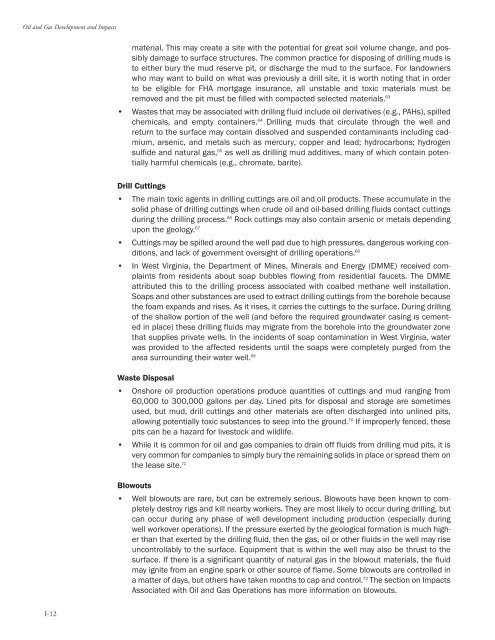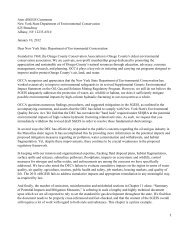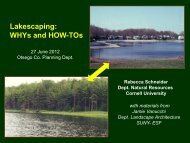Oil and Gas at Your Door? (2005 Edition) - Earthworks
Oil and Gas at Your Door? (2005 Edition) - Earthworks
Oil and Gas at Your Door? (2005 Edition) - Earthworks
Create successful ePaper yourself
Turn your PDF publications into a flip-book with our unique Google optimized e-Paper software.
<strong>Oil</strong> <strong>and</strong> <strong>Gas</strong> Development <strong>and</strong> Impacts<br />
m<strong>at</strong>erial. This may cre<strong>at</strong>e a site with the potential for gre<strong>at</strong> soil volume change, <strong>and</strong> possibly<br />
damage to surface structures. The common practice for disposing of drilling muds is<br />
to either bury the mud reserve pit, or discharge the mud to the surface. For l<strong>and</strong>owners<br />
who may want to build on wh<strong>at</strong> was previously a drill site, it is worth noting th<strong>at</strong> in order<br />
to be eligible for FHA mortgage insurance, all unstable <strong>and</strong> toxic m<strong>at</strong>erials must be<br />
removed <strong>and</strong> the pit must be filled with compacted selected m<strong>at</strong>erials. 63<br />
• Wastes th<strong>at</strong> may be associ<strong>at</strong>ed with drilling fluid include oil deriv<strong>at</strong>ives (e.g., PAHs), spilled<br />
chemicals, <strong>and</strong> empty containers. 64 Drilling muds th<strong>at</strong> circul<strong>at</strong>e through the well <strong>and</strong><br />
return to the surface may contain dissolved <strong>and</strong> suspended contaminants including cadmium,<br />
arsenic, <strong>and</strong> metals such as mercury, copper <strong>and</strong> lead; hydrocarbons; hydrogen<br />
sulfide <strong>and</strong> n<strong>at</strong>ural gas, 65 as well as drilling mud additives, many of which contain potentially<br />
harmful chemicals (e.g., chrom<strong>at</strong>e, barite).<br />
Drill Cuttings<br />
• The main toxic agents in drilling cuttings are oil <strong>and</strong> oil products. These accumul<strong>at</strong>e in the<br />
solid phase of drilling cuttings when crude oil <strong>and</strong> oil-based drilling fluids contact cuttings<br />
during the drilling process. 66 Rock cuttings may also contain arsenic or metals depending<br />
upon the geology. 67<br />
• Cuttings may be spilled around the well pad due to high pressures, dangerous working conditions,<br />
<strong>and</strong> lack of government oversight of drilling oper<strong>at</strong>ions. 68<br />
• In West Virginia, the Department of Mines, Minerals <strong>and</strong> Energy (DMME) received complaints<br />
from residents about soap bubbles flowing from residential faucets. The DMME<br />
<strong>at</strong>tributed this to the drilling process associ<strong>at</strong>ed with coalbed methane well install<strong>at</strong>ion.<br />
Soaps <strong>and</strong> other substances are used to extract drilling cuttings from the borehole because<br />
the foam exp<strong>and</strong>s <strong>and</strong> rises. As it rises, it carries the cuttings to the surface. During drilling<br />
of the shallow portion of the well (<strong>and</strong> before the required groundw<strong>at</strong>er casing is cemented<br />
in place) these drilling fluids may migr<strong>at</strong>e from the borehole into the groundw<strong>at</strong>er zone<br />
th<strong>at</strong> supplies priv<strong>at</strong>e wells. In the incidents of soap contamin<strong>at</strong>ion in West Virginia, w<strong>at</strong>er<br />
was provided to the affected residents until the soaps were completely purged from the<br />
area surrounding their w<strong>at</strong>er well. 69<br />
Waste Disposal<br />
• Onshore oil production oper<strong>at</strong>ions produce quantities of cuttings <strong>and</strong> mud ranging from<br />
60,000 to 300,000 gallons per day. Lined pits for disposal <strong>and</strong> storage are sometimes<br />
used, but mud, drill cuttings <strong>and</strong> other m<strong>at</strong>erials are often discharged into unlined pits,<br />
allowing potentially toxic substances to seep into the ground. 70 If improperly fenced, these<br />
pits can be a hazard for livestock <strong>and</strong> wildlife.<br />
• While it is common for oil <strong>and</strong> gas companies to drain off fluids from drilling mud pits, it is<br />
very common for companies to simply bury the remaining solids in place or spread them on<br />
the lease site. 71<br />
Blowouts<br />
• Well blowouts are rare, but can be extremely serious. Blowouts have been known to completely<br />
destroy rigs <strong>and</strong> kill nearby workers. They are most likely to occur during drilling, but<br />
can occur during any phase of well development including production (especially during<br />
well workover oper<strong>at</strong>ions). If the pressure exerted by the geological form<strong>at</strong>ion is much higher<br />
than th<strong>at</strong> exerted by the drilling fluid, then the gas, oil or other fluids in the well may rise<br />
uncontrollably to the surface. Equipment th<strong>at</strong> is within the well may also be thrust to the<br />
surface. If there is a significant quantity of n<strong>at</strong>ural gas in the blowout m<strong>at</strong>erials, the fluid<br />
may ignite from an engine spark or other source of flame. Some blowouts are controlled in<br />
a m<strong>at</strong>ter of days, but others have taken months to cap <strong>and</strong> control. 72 The section on Impacts<br />
Associ<strong>at</strong>ed with <strong>Oil</strong> <strong>and</strong> <strong>Gas</strong> Oper<strong>at</strong>ions has more inform<strong>at</strong>ion on blowouts.<br />
I-12




